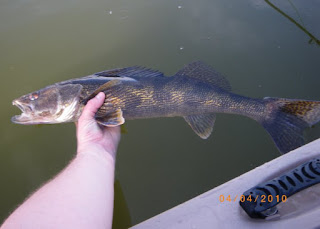Typically, we spend most of our time on larger water, but I have a serious addiction to small stream fishing and had been hoping for a while to explore some new water. Our first stop on the trip would be a small stream not far from our primary destination. The scenery of the area, with leaves changing colors and the natural beauty of the stream, was spectacular. My hopes of dry fly fishing were quickly dashed, as it was obvious that the fish didn't want surface offerings. I settled on a tandem nymph rig of an Ice Hare's Ear and Egan's Red Dart, which produced quite well. Most of the fish were smaller rainbows.
I approached a juicy looking run below a riffle and positioned myself for a good drift. I briefly saw the flash of a fish as it came a few inches to the right to intercept my rig and quickly came tight to a solid fish that flexed the 3wt nicely. What came to hand several seconds later was one of the prettier wild brown trout I have ever landed. The little chunker eagerly took the Red Dart I had tied a few days prior to the trip.
Trout do live in some beautiful settings. It doesn't get much better than this, especially having it to yourselves the entire morning.
After fishing most of the morning on small water, we changed venues over to the primary destination: the South Holston River. To that point in the day, the weather had mildly cooperated. It wasn't all that cold, and the rain had mostly held off. Not long after arriving at the South Holston, that all changed.
As the rain picked up and the air temperatures began to drop, the fishing remained constant. Fish were still rising on sulfurs and were willing to eat a well presented fly. My typical top two flies for the area, a small bugger-ish concoction and a yellow Mil-Spec (see https://www.youtube.com/watch?v=X-zcuYATAgQ for Mil Spec info) soft hackle, produced a lot of aggressive rainbows. That soft hackle swung through rising fish produced a lot of action...and a lot of frustration with breaking off on 6X tippet.
Approaching dusk, we were wet and cold. Rain gear had kept some of the water off of me, but a not-so-planned little swim I took early on at the South Holston had me pretty damp and chilled. My friend and I returned to our cabin and changed into warm clothes, then made the trip a town over to our favorite local pizza place, Jiggy Ray's. As always, Jiggy Ray's did not disappoint.
Overnight the temperatures continued to fall, and so did the rain. Our plan for the morning was to fish the Watauga River, but we quickly found this plan to be nixed when we saw the river. Upon arrival, the Watauga was murky and nasty looking. Off color water would have been fine to fish, but we chose not to brave the muddy conditions and instead returned to the South Holston near the dam to find some cleaner water. The trout there were feeding, but were very selective and "being a__holes," as I sometimes say. A few fish came to chilly hands, but the fishing was not as great as we had hoped. My friend did manage to catch a gorgeous brown on an emerger pattern, only to have the fish self-release as I was preparing to snap a photo. We picked up a few fish, then the bitter cold claimed victory.
I don't believe the heat was tuned down n the truck until we left the state, as neither of us could get warmed up. It was especially rough on my friend who had leaky waders to contend with on a 30 degree morning. Although the weather was rough at times, the trip did not disappoint. We caught our share of gorgeous trout, enjoyed some amazing pizza, and unplugged for two days in some of the most gorgeous scenery you can find. I'll be back in the area again next year, and I really hope the rain can stay away when that time comes.





























